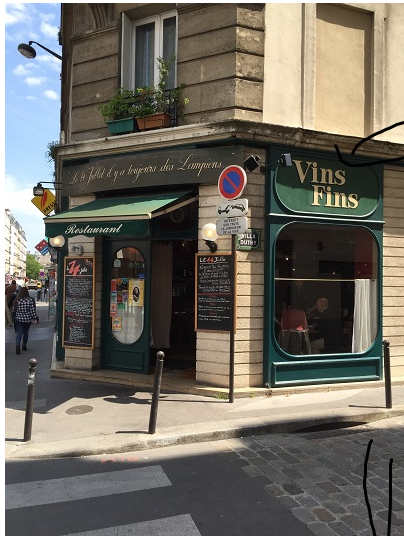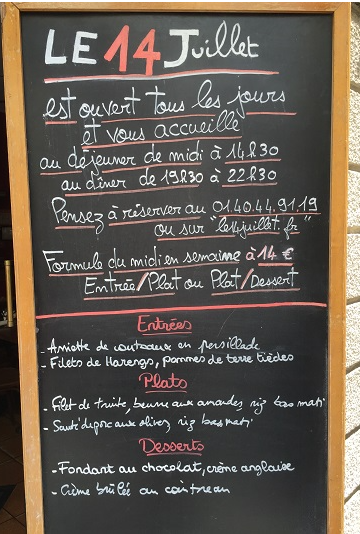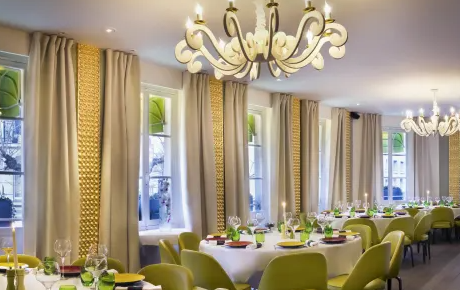Neighborhood Dining in Alesia
- Jerry Marterer
- Jun 3, 2021
- 5 min read
Updated: Aug 5, 2021
By Jerry Marterer

Images provided by the author.
For many years (though not last year or this year) I have spent the first two weeks of June in Paris alone after an annual business meeting and used the time to do research while my wife stays behind and attends Spoleto events with friends. Each day, I try a different family-owned restaurant in little-known neighborhoods where the locals live and eat. When my first impressions are positive, I wait until my wife arrives later in the month and we return to confirm my original verdict with her second opinion. We have never disagreed. Only then do I make recommendations to others, and we make repeat visits during our longer stays. Throughout the years in Paris, we have become “lunch people,” preferring a midday meal in one of the authentic neighborhood places and then a salad or soup at home in the evening.
The Alesia neighborhood in the 14th arrondissement appears to be self-sufficient. It is quiet, residential and middle class with good retail shopping and some streets lined with small restaurants that draw locals every day. Even the name sounds pleasant. There are no famous monuments here. The major attraction for tourists is underneath the quarter, a section of the Paris Catacombs that is open to the public. The 92 bus and number 4 Metro stop near the corner of avenue Maine and the rue d’Alesia. Across the street from the stop is the center of the quarter, the Church of Saint-Pierre de Montrouge.
L’Ordonnance

Near the bus and metro stop at 51 rue Hallé is a neighborhood “menu on the chalkboard” place that has us returning month after month. It is a family-run operation and fills up each day at lunchtime. The gray exterior with yellow trim is a pleasant sight that begs you to come inside its cozy dining room. The chalkboard is hung outside near the door. On my first visit, I had the perfect lunch. The entrée du jour (first course) was couteaux, or razor clams. I am not fond of clams, so I ordered from their “carte,” a list of everyday offerings that doesn’t change. I was intrigued by the “purée de champignons en duxelles, oeuf poché et ventrèche grillée” — a lot of French words for a simple and delightful dish that is essentially diced, cooked and puréed mushrooms topped by a poached egg and grilled thick bacon. It was a fall dish and a perfect start to the meal. The plat du jour (main course) was quasi de veau, a small veal tenderloin served with shiitake mushrooms and creamy risotto. I paired it with a glass of red Côte du Rhône.
Next came the dessert de jour on the chalkboard: a sugared tart of fresh figs topped by fig sorbet. The 37-euro tab for a three-course lunch with wine could have been twice as much elsewhere. Note that in France there is no added sales tax or gratuity, but it is customary to leave a few euro coins after a pleasant meal.
Les Petits Plats
We found another gem several blocks away in the Alesia neighborhood. I almost decided to not write about the bistro Les Petits Plats at 39 rue des Plantes. I was being selfish, trying to keep it all for myself, but I eventually relented. If you go to only one place in this area for a weekday lunch, let it be this one. A nondescript façade houses a 1910-era dining room featuring wood and brass fixtures with a genuine worn patina — even a cracked mirror behind the bar. Their motto is “Cuisine Canaille,” meaning food for the common people. But there is nothing common about it. The food is beautiful! It makes everyone in the place smile! Don’t look for beef Burgundy or coq au vin. They create sensational dishes that defy categories. When I sat down, a plate of toasted baguette slices and a ramekin of homemade tapenade quickly arrived as an amuse bouche, or appetizer, a nice touch. I ate all of it. The menu du jour had one starter and one main course. My French wasn’t good enough to understand what they were, but I saw the young, hip-looking waitstaff bring what looked like the same dishes to everyone. I said, “Je prends le menu du jour,” and it was the best decision I ever made.

I took a photo of the chalkboard and looked everything up later. The first course was velouté du Barry, a creamy, thick cauliflower soup named after Madame du Barry, the mistress of Louis XV, who supposedly had it made for her to consume every day. It was with sprinkled bits of nut and chorizo, just enough for a nuance. What followed was another surprise, a ballotine de volailles, chicken breasts pureed with herbs, eggs, double cream and tarragon, then made into sausages without skins. It was served over risotto in a bisque. But there was something else! Black seeds gave it a wonderful smoky taste. I asked and was told they were toasted butternut squash seeds. A half-carafe of white Burgundy was perfect company. I continued my amazement with the dessert, an entire peeled and poached pear, sitting upright, with a tiny scoop of caramel ice cream and crumbled brown sugar. At Les Petits Plats, they clearly understand that a hint of something is more seductive that a dollop! All this at neighborhood prices, around 30 euros for three courses with wine.
Le Quatorze Juillet
The rue Didot crosses the rue d’Alesia and hosts a dozen small restaurants. The first one I tried was the Quatorze Juillet, named after the French National Holiday (Bastile Day) on number 99, a classic one-room restaurant with a young and energetic staff. A sidewalk ardoise (chalkboard) had the menu du jour at the unbelievable price of 14 euros for either an entrée (always the first course in France) and a plat (main course) or a main course and dessert. I entered and was shown to a small table. Immediately, I was brought a plate of sliced hard sausage — a nice touch.
The entrees were:
Couteaux (razor clams) with persillade (a sauce made with parsley, garlic and olive oil)
Herring filets with warm potatoes
For the plats:
Trout filet with almond butter and basmati rice
Sautéed pork with olives and basmati rice
For dessert:
Chocolate fondant with crème Anglaise (a buttery cream sauce)
Crème brûlée with Cointreau liquor
I chose the herring. The slightly smoky herring and warm potatoes were lightly bathed in a warm vinaigrette.
The pork sautée with olives is a classic French dish, and I jumped at it. The pork pieces are sautéed in olive oil and herbs, then olives are added and everything is finished in white wine and cream. The olives provided a tangy balance to the cream sauce. I ordered a carafe of Rasteau, a southwestern red that held up well to both courses.

The lunch was tasty and filling, so I skipped dessert. You will never find a better meal in Paris for 14 euros.
Moulin Vert
On the rue des Plantes north of the rue d’Alesia is a landmark restaurant that is anything but a one-room Mom-and-Pop. The Moulin Vert (the Green Windmill) is famous for its seafood and fixed-price menu. It is a regular stop for Sunday lunch. In pleasant weather, outdoor tables fill with local businessmen during the week. For lunch, there is a three-course menu: entrée, plat and dessert for 21 euros. Their 46-euro all-inclusive menu is also available at lunch- and dinnertime. It starts with an apéritif, usually Kir, then a choice of six different entrées and eight main courses, followed by a dessert selection and café. A bottle of wine for two persons is also included. The dining rooms are airy and bright. The locals love this place.
We still have not run out of new places to try in this quarter, and it is always worth one or two stops on each visit to Paris.
Jerry Marterer is the author of Paris 201 — Uncommon Places in the City of Light. He and his wife, Suzanne, divide their time between Charleston and Paris; he may be reached at jmarterer@bellsouth.net.









































